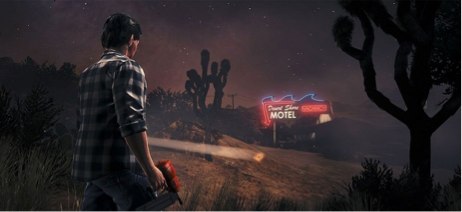Remedy Entertainment’s critically acclaimed Alan Wake was intended to be the first installment of a planned franchise—the developers referred to it as the “first season” due to the game’s episodic presentation. Initial game sales, however, were less than stellar and there was a great deal of doubt that the franchise would be able to continue. Thankfully for fans of the troubled writer, Remedy was able to bring Alan back for a second outing in a standalone adventure set in the fictional Night Springs.

It’s been two years since the first installment and that time is reflected in-game as Alan finds himself still trapped in the dark place after the events of Alan Wake. Over the years, the writer has seemingly grown more comfortable with his situation and is making another attempt to break out—a seemingly impossible feat.
While it certainly helps to have prior knowledge of the writer and his plight, Remedy made sure that American Nightmare would be easily accessible to potential new players. As in the first game, manuscript pages are hidden throughout the environments and provide insight on the events that surround Alan’s new adventure; this is useful for easing in new players to the lore as well as offering a refresher course to fans who haven’t made their way through Alan’s Bright Falls adventure in some time.
The tale weaved in American Nightmare pits Alan Wake against his evil doppelganger, Mr. Scratch, in a small town in Arizona known as Night Springs. The town gets its name from the Twilight Zone-inspired, fictional television series from the Alan Wake canon—the same television series where Alan got his start as a professional writer. Using his ties to the show as an anchor to reality, Alan hopes to finally find his way out of the dark place. It’s an interesting tale that takes more cues from “grindhouse” features and Quentin Tarantino films than Twin Peaks or the works of Stephen King which served as inspirations for the first game.

This shift in inspiration in story leads to a greater focus on combat than was present in the first game. The two-tiered combat from the first (with a light source being necessary to remove the darkness surrounding the taken and a gun to ultimately dispatch them) is still as satisfying and intense as ever, but ammo and flashlight batteries are much easier to procure as there’s an abundance of infinitely replenishing supply caches in each level. Flashlight batteries also recharge noticeably faster in American Nightmare than they did in Wake’s first outing, but this is balanced requiring that the light be focused in order to damage the darkness. The abundance of ammunition and batteries don’t detract from the intensity, however, as new enemies abound and come in furious waves to hinder Mr. Wake’s progression.
Complimenting the story is a new arcade mode dubbed “Fight Till Dawn.” In this mode, players face off against waves of enemies in various environments in attempts to survive until dawn. This arcade mode is entirely focused on the combat and definitely adds an addictive boost to the game’s replayability.
Alan Wake’s American Nightmare is, primarily, a game for the fans; it not only gives hope that the franchise still has life in it, but also answers several questions while asking a thousand more. It takes the existing fiction and builds upon it by expanding the universe in a wonderfully self-aware, pulp fiction romp through an Arizona desert. Sam Lake, the creator of Alan Wake, and the team at Remedy have crafted a worthwhile experience for fans and new players alike. Alan Wake’s American Nightmare is an exhilarating experience with plenty of content to keep players invested for several hours, and one that is surely worth a try.
Alan Wake’s American Nightmare was developed by Remedy Entertainment and published by Microsoft Studios; it is currently available exclusively on Xbox Live Arcade for 1200 Microsoft Points ($15).
VentureBeat's mission is to be a digital town square for technical decision-makers to gain knowledge about transformative enterprise technology and transact. Learn More
